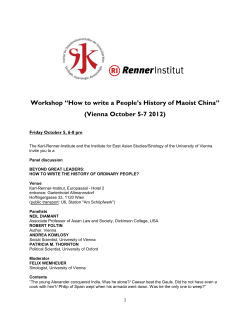
Why You Should Run TPC-DS: A Workload Analysis Meikel Poess Raghunath Othayoth Nambiar
Why You Should Run TPC-DS:
A Workload Analysis
Meikel Poess
Raghunath Othayoth Nambiar
Oracle USA
Hewlett-Packard Company
Dave Walrath
Sybase Inc
(in absentia)
Agenda
•
•
•
•
•
•
Transaction Processing Performance Council (TPC)
Scope of TPC-DS benchmark
TPC-DS Design Considerations
TPC-DS Workload Analysis
TPC-DS Metric Analysis
Q&A
33nd International Conference on Very Large Data Bases, September 23-27 2007, University of Vienna, Austria
2
Transaction Processing Performance Council
•
The TPC defines transaction processing and database benchmarks
and delivers trusted results to the industry.
• Most credible, system-level benchmark evaluation test for the server
industry
• Fulfilling the role of a “Consumer Reports” for the computing industry
• Scores are the most requested server benchmarks in server RFPs
•
Active benchmarks
• TPC-C: Online transaction processing
• TPC-H: Data Warehouse for ad hoc queries
• TPC-App: Application server and web services
• TPC-E: Online transaction processing (new)
•
Benchmarks under development
• TPC-DS: Decision Support
33nd International Conference on Very Large Data Bases, September 23-27 2007, University of Vienna, Austria
3
TPC Membership
33nd International Conference on Very Large Data Bases, September 23-27 2007, University of Vienna, Austria
4
What makes the TPC unique
•
TPC is the only benchmark organization that requires priceperformance scores across all of its benchmarks
•
All tests require full documentation of the components and
applications under test, so that the test can be replicated
•
The TPC requires an independent audit of results prior to
publication
•
Extensive oversight via fair use policies
•
TPC tests the whole system performance, not just a piece
•
TPC is database agnostic: Oracle, IBM DB2, Sybase, Microsoft
SQL Server, NonStop SQL/MX and other databases
•
TPC provides cross-platform performance comparisons, a view
of processor versus real performance, technology comparisons
and actual cost of performance comparisons
33nd International Conference on Very Large Data Bases, September 23-27 2007, University of Vienna, Austria
5
Objectives of TPC Benchmarks
•
System and database vendors
− Competitive analysis
− Release to release progress
− Technology development
•
Customers
−
−
−
−
•
Cross vendor/architecture performance comparison
Cross vendor/architecture TCO comparison
Evaluate new technologies
Eliminate investment in in-house characterization
Research community
− A standard yet customizable workload
33nd International Conference on Very Large Data Bases, September 23-27 2007, University of Vienna, Austria
6
TPC’s DW/DSS Benchmark History
•
TPC-D - Data Warehouse (1995-1999)
•
TPC-R - Data Warehouse for reporting queries (99-04)
•
TPC-H - Data Warehouse for ad hoc queries (99current)
•
TPC-DS - Decision Support (target 2008)
− Latest status and specification
• http://www.tpc.org/tpcds/default.asp
− Series of Presentations
• TPC-DS, Taking Decision Support Benchmarking to the Next
Level, SIGMOD 2002
• The Making of TPC-DS, VLDB 2006
• Why You Should Run TPC-DS: Workload Analysis, VLDB 2007
33nd International Conference on Very Large Data Bases, September 23-27 2007, University of Vienna, Austria
7
Scope of TPC DS Benchmark
•
Measures generally applicable aspects of a Decision
Support System
−
−
−
−
Examine large volume of data
Give answers to real-world business questions
Execute queries of various operational requirements
Generate intense activity against the database server
component of a system (IO, memory, CPU, Interconnect)
− Remain closely synchronized with source OLTP database
through a periodic database maintenance function
•
Provides the industry
− An objective means of comparing
• the performance of decision support systems
• the price-performance of decision support systems
− A standard yet customizable workload
Gartner Inc. showed business intelligence (BI) as a top priority for CIOs.
http://www.gartner.com/2_events/conferences/bie7i.jsp
33nd International Conference on Very Large Data Bases, September 23-27 2007, University of Vienna, Austria
8
TPC
• Decision Support Benchmark
•
•
•
•
Hardware
Representative
Large Query Set
Non-Uniform Data Set
Ad-Hoc and Reporting Queries
…
• Exercise
CPU
Disk IO (Read and Write)
Memory
Serve
• Intensive Load on
Sometimes in conflict
TPC-DS
En
ab
le
bl
e
• Metric reflects all above
• Architectural Neutral
…
•
•
•
•
•
•
Query Optimizer
Data Storage Methods
Data Access Methods
Join Methods
Sort/GB Algorithms
Complex ADS
…
En
a
•
•
•
Database
• Simple Metric
• System Realism
• Application Realism
…
Benchmark Consumer
33nd International Conference on Very Large Data Bases, September 23-27 2007, University of Vienna, Austria
9
Benchmark Execution: Bird’s Eye View
System
Setup
Database
Setup
Un-timed
Database
Load
Query +
Run #1
ETL #1
Query
Run #2
+
ETL #2
Timed
••Setup
Queryof:
Run
#1
•Creation
•Database
of:Load
nMaintenance-ETL
concurrent
users
••• Runs
Data
•Servers/
Operating
Data
Maintenance-ETL
#2
•Load
•System
of raw
tables
data System #1
• each
users
executes
99 queries
•Load
fact
tables
•Storage
Arrays
•Load into
into
factincluding
tables RAID
•Creation
•Tablefrom
of
spaces
auxiliary
data
•Delete
fact
tables
•Delete
from
fact
tables
•Repeat
of Query Run #1
•Networks
structures
•Maintain
slowly
changing
•File Groups
•Maintain
slowly
changing
•Database
Software
dimensions
•Statistics
gathering
dimensions
•Log
files
•Flat files (optional)
33nd International Conference on Very Large Data Bases, September 23-27 2007, University of Vienna, Austria
10
Hardware Vendor
Requirements
Implementation
CPU
CPU bound queries
Disk IO
IO bound queries
Read and Write IO
ETL
Balanced Query Mix
Large query set/concurrent user
Memory Access
Large hash/joins, sorts, GB
Architectural Neutral
ANSI SQL, wide industrial
representation in TPC
Metric reflects all
of the above
Metric includes Load, Query
and ETL performance
33nd International Conference on Very Large Data Bases, September 23-27 2007, University of Vienna, Austria
11
Database Vendor
Requirements
Query Optimizer
Implementation
Rich Query Set:
- star transformation and traditional large
join operations
Rich Data Set:
- NULLs +non-uniform distributions
Join Operations
Multiple Snowflake Schemas:
- Nested Loops
- Hash Joins
- Bitmap Joins
Sort/GB Operations
Complex ADS
Sort/GB on large data sets
ADS are allowed on a subset of
the schema
Data Storage Techniques
Physical Partitioning
/Clustering/Compression
Query Set allows for large
sequential scans and random IOs
Data Access Patterns
33nd International Conference on Very Large Data Bases, September 23-27 2007, University of Vienna, Austria
12
Query Run
•
The query run tests the system’s ability to
execute the most number of queries in the
least amount of time (multi user test)
•
Queries can be categorized by:
− Query Class
•
•
•
•
Ad Hoc
Reporting
Iterative
Data Mining Queries
− Schema Coverage
− Resource Utilization − SQL Features
33nd International Conference on Very Large Data Bases, September 23-27 2007, University of Vienna, Austria
13
Query Categorization by Resource Utilization
33nd International Conference on Very Large Data Bases, September 23-27 2007, University of Vienna, Austria
14
CPU Intensive Query (Query 70)
SELECT
sum(ss_net_profit) as total_sum. s_state,s_county
,grouping(s_state)+grouping(s_county)
,rank()over(partition by grouping(s_state)
+grouping(s_county)
,case when grouping(s_county)=0
then s_state end
order by sum(ss_net_profit) desc)
FROM store_sales ,date_dim ,store
WHERE d_year = [YEAR]
AND d_date_sk = ss_sold_date_sk AND s_store_sk = ss_store_sk
AND s_state in
(SELECT s_state
FROM (SELECT
s_state ,rank()over(partition by s_state
order by sum(ss_net_profit)desc) as r
FROM store_sales,store,date_dim
WHERE d_year =[YEAR]
AND d_date_sk = ss_sold_date_sk AND s_store_sk = ss_store_sk
GROUP BY s_state)
WHERE r <= 5)
GROUP BY ROLLUP(s_state,s_county)
ORDER BY
lochierarchy desc
,CASE WHEN lochierarchy = 0 THEN s_state END
,rank_within_parent;
33nd International Conference on Very Large Data Bases, September 23-27 2007, University of Vienna, Austria
15
IO Intensive Query (82)
SELECT i_item_id
,i_item_desc
,i_current_price
FROM item, inventory
,date_dim ,store_sales
WHERE i_current_price between [P] and [P] + 30
AND inv_item_sk = i_item_sk
AND d_date_sk=inv_date_sk
AND d_date between cast('[DATE]' as date)
AND (cast('[DATE]' as date)+60)
AND i_manufact_id IN ([ID.1],[ID.2],[ID.3])
AND inv_quantity_on_hand between 100 and 500
AND ss_item_sk = i_item_sk
GROUP BY i_item_id
,i_item_desc
,i_current_price
ORDER BY i_item_id;
33nd International Conference on Very Large Data Bases, September 23-27 2007, University of Vienna, Austria
16
Data Maintenance Functions
•
Are defined as pseudo code
•
Can be implemented in SQL, or
programming SQL
•
Need to guarantee referential integrity
•
Maintain slowly changing dimensions
•
Insert and delete fact tables
33nd International Conference on Very Large Data Bases, September 23-27 2007, University of Vienna, Austria
17
Updates/Inserts/Deletes (non history keeping)
Dimension
Dimension entries are identified
by their business key and all
changed fields are updated.
33nd International Conference on Very Large Data Bases, September 23-27 2007, University of Vienna, Austria
18
Updates/Inserts/Deletes (history keeping)
Dimension
Dimension entries are identified
by their business key and
end_rec_date=NULL
Then rows is updated by setting
end_rec_date to new date
New row is inserted
33nd International Conference on Very Large Data Bases, September 23-27 2007, University of Vienna, Austria
19
Deletes/Inserts Fact Tables
Assuming
partitioning by
sales date, sales
are deleted by
date range
Fact Table Sales
Fact Table Returns
Return rows might
be scattered
33nd International Conference on Very Large Data Bases, September 23-27 2007, University of Vienna, Austria
20
Primary Performance Metric
•
Queries per Hour
QphDS @ SF
−
−
−
−
=
99 * 2 * S * 3600 * SF
T TT 1 + T TT 2 + 0.01*S * T Load
(
)
S: Number of query streams
SF: Scale Factor
TTT1 and TTT2: elapsed times to complete query run #1 and #2
TLOAD is the total elapsed time to complete the database load
33nd International Conference on Very Large Data Bases, September 23-27 2007, University of Vienna, Austria
21
Metric Analysis: Use of Materialization
33nd International Conference on Very Large Data Bases, September 23-27 2007, University of Vienna, Austria
22
More Information
•
Specification
•
Dbgen2
•
Qgen2
•
Query templates
http://www.tpc.org/tpcds/default.asp
33nd International Conference on Very Large Data Bases, September 23-27 2007, University of Vienna, Austria
23
Q&A
33nd International Conference on Very Large Data Bases, September 23-27 2007, University of Vienna, Austria
24
© Copyright 2025









